Genome-Wide Identification and Expression Analysis of MYB Transcription Factor Family in Response to Various Abiotic Stresses in Coconut (Cocos nucifera L.)
Abstract
:1. Introduction
2. Results
2.1. CnMYB Genome-Wide Identification and Sequence Analysis
2.2. Phylogenetic Relationship Analysis of MYBs in Coconut and Arabidopsis
2.3. Gene Structure and Motif Composition
2.4. Synteny Analysis
2.5. Gene Ontology Enrichment Analysis
2.6. Key Homologous Genes Analysis
2.7. Analysis of Cis-Regulatory Elements
2.8. Effects of Abiotic Stress on Growth of Coconut Seedlings
2.9. Analysis of Gene Expression
2.10. Protein Structure Analysis
2.11. Protein Interaction Network Prediction
3. Discussion
3.1. MYB Transcription Factor in Coconut
3.2. Analysis of the Expression Pattern and Abiotic Stress Resistance Function of CnMYBs
4. Materials and Methods
4.1. Identification and Analysis of Coconut MYB Family Genes
4.2. Phylogenetic Analysis
4.3. Analysis of Conserved Motifs, Gene Structures, and Chromosomal Distribution
4.4. Ka/Ks Analyses and Gene Collinearity
4.5. Gene Ontology Enrichment and Cis-Regulatory Elements
4.6. Plant Growth and Treatments
4.7. Quantitative Real-Time PCR Analysis
4.8. Protein Secondary Structure Prediction and Tertiary Structure Construction
4.9. Construction of the Protein Interaction Network
4.10. Statistical Analysis
5. Conclusions
Supplementary Materials
Author Contributions
Funding
Institutional Review Board Statement
Informed Consent Statement
Data Availability Statement
Conflicts of Interest
References
- Yousefi, K.; Abdullah, S.N.A.; Hatta, M.A.M.; Ling, K.L. Genomics and Transcriptomics Reveal Genetic Contribution to Population Diversity and Specific Traits in Coconut. Plants 2023, 12, 1913. [Google Scholar] [CrossRef] [PubMed]
- Valliyodan, B.; Nguyen, H.T. Understanding regulatory networks and engineering for enhanced drought tolerance in plants. Curr. Opin. Plant Biol. 2006, 9, 189–195. [Google Scholar] [CrossRef] [PubMed]
- Zhao, Y.G.; Zhang, G.L.; Wen-Jun, Z.; Gong, Z.T. Soil characteristics and crop suitability of sandy soils in Hainan, China. In Management of Tropical Sandy Soils for Sustainable Agriculture “A Holistic Approach for Sustainable Development of Problem Soils in the Tropics”; The Food and Agriculture Organization of the United Nations: Rome, Italy, 2005; pp. 49–66. [Google Scholar]
- Ramírez-Silva, J.H.; Cortazar-Ríos, M.; Ramírez-Jaramillo, G.; Oropeza-Salín, C.M.; Rondón-Rivera, D.D. Soil organic matter and nitrogen content as related to coconut nutrition in Guerrero, Mexico. Open Access Libr. J. 2021, 8, 1–16. [Google Scholar] [CrossRef]
- Ma, Y.; Mu, X.; Hou, P.; Sun, L.; Zhang, L. Remote Sensing Identification and Spatial Variation of Drought Characteristics in Hainan Island. Remote Sens. Technol. Appl. 2022, 37, 1159–1169. [Google Scholar] [CrossRef]
- Lu, L.; Fan, L.; Pei, L.; Zou, S.; Lin, Y.; Deng, R.; Wang, Z. Groundwater resources and environmental geologic problems on Hainan Island. Geol. China 2022, 51, 499–510. [Google Scholar] [CrossRef]
- Rajagopal, V.; Bai, K.V.K.; Kumar, N. Breeding for drought tolerance in coconut: Status and potentials. In Coconut Genetic Resources; International Plant Genetic Resources Institute-Regional Office for Asia, the Pacific and Oceania (IPGRI-APO): Serdang, Malaysia, 2005; pp. 282–301. [Google Scholar]
- Waidyarathne, P.; Perera, C. Extreme Weather Events and Crop Yields: A Case Study with Coconut; The Institute of Biology, Sri Lanka: Colombo, Sri Lanka, 2020; pp. 153–166. [Google Scholar]
- Isayenkov, S.V.; Maathuis, F.J.M. Plant Salinity Stress: Many Unanswered Questions Remain. Front. Plant Sci. 2019, 10, 80. [Google Scholar] [CrossRef]
- Zhou, L.; Cao, H.; Liu, Y. Effects of seawater stress on physiological and biochemical characteristics of coconut seedling. J. South. Agric. 2018, 49, 2013–2019. [Google Scholar] [CrossRef]
- Baillo, E.H.; Kimotho, R.N.; Zhang, Z.; Xu, P. Transcription Factors Associated with Abiotic and Biotic Stress Tolerance and Their Potential for Crops Improvement. Genes 2019, 10, 771. [Google Scholar] [CrossRef]
- Li, Y.; Kui, L.-W.; Zhen, L.; Allan, A.C.; Qin, S.; Zhang, J.; Liu, Y. Genome-wide analysis and expression profiles of the StR2R3-MYB transcription factor superfamily in potato (Solanum tuberosum L.). Int. J. Biol. Macromol. 2020, 148, 817–832. [Google Scholar] [CrossRef]
- Du, H.; Wang, Y.-B.; Xie, Y.; Liang, Z.; Jiang, S.-J.; Zhang, S.-S.; Huang, Y.-B.; Tang, Y.-X. Genome-Wide Identification and Evolutionary and Expression Analyses of MYB-Related Genes in Land Plants. DNA Res. 2013, 20, 437–448. [Google Scholar] [CrossRef]
- Stracke, R.; Werber, M.; Weisshaar, B. The R2R3-MYB gene family in Arabidopsis thaliana. Curr. Opin. Plant Biol. 2001, 4, 447–456. [Google Scholar] [CrossRef] [PubMed]
- Kanei-Ishii, C.; Sarai, A.; Sawazaki, T.; Nakagoshi, H.; He, D.N.; Ogata, K.; Nishimura, Y.; Ishii, S. The tryptophan cluster: A hypothetical structure of the DNA-binding domain of the myb protooncogene product. J. Biol. Chem. 1990, 265, 19990–19995. [Google Scholar] [CrossRef] [PubMed]
- Ito, M. Conservation and diversification of three-repeat Myb transcription factors in plants. J. Plant Res. 2005, 118, 61–69. [Google Scholar] [CrossRef]
- Cao, Z.-H.; Zhang, S.-Z.; Wang, R.-K.; Zhang, R.-F.; Hao, Y.-J. Genome Wide Analysis of the Apple MYB Transcription Factor Family Allows the Identification of MdoMYB121 Gene Confering Abiotic Stress Tolerance in Plants. PLoS ONE 2013, 8, e69955. [Google Scholar] [CrossRef] [PubMed]
- Matus, J.T.; Aquea, F.; Arce-Johnson, P. Analysis of the grape MYB R2R3 subfamily reveals expanded wine quality-related clades and conserved gene structure organization across Vitis and Arabidopsis genomes. BMC Plant Biol. 2008, 8, 83. [Google Scholar] [CrossRef] [PubMed]
- Katiyar, A.; Smita, S.; Lenka, S.K.; Rajwanshi, R.; Chinnusamy, V.; Bansal, K.C. Genome-wide classification and expression analysis of MYB transcription factor families in rice and Arabidopsis. BMC Genom. 2012, 13, 544. [Google Scholar] [CrossRef]
- Zhang, W.; Wu, J.; He, J.; Liu, C.; Yi, W.; Xie, J.; Wu, Y.; Xie, T.; Ma, J.; Zhong, Z.; et al. AcMYB266, a key regulator of the red coloration in pineapple peel: A case of subfunctionalization in tandem duplicated genes. Hortic. Res. 2024, 11, uhae116. [Google Scholar] [CrossRef]
- Li, J.; Guo, S.; Min Htwe, Y.; Sun, X.; Zhou, L.; Wang, F.; Zeng, C.; Chen, S.; Iqbal, A.; Yang, Y. Genome-wide identification, classification and expression analysis of MYB gene family in coconut (Cocos nucifera L.). Front. Plant Sci. 2024, 14, 1263595. [Google Scholar] [CrossRef]
- Roy, S. Function of MYB domain transcription factors in abiotic stress and epigenetic control of stress response in plant genome. Plant Signal. Behav. 2016, 11, 1117723. [Google Scholar] [CrossRef]
- Liu, Y.; Wang, M.; Huang, Y.; Zhu, P.; Qian, G.; Zhang, Y.; Li, L. Genome-Wide Identification and Analysis of R2R3-MYB Genes Response to Saline-Alkali Stress in Quinoa. Int. J. Mol. Sci. 2023, 24, 9132. [Google Scholar] [CrossRef]
- Zhang, Y.; He, Z.; Qi, X.; Li, M.; Liu, J.; Le, S.; Chen, K.; Wang, C.; Zhou, Y.; Xu, Z.; et al. Overexpression of MYB-like transcription factor SiMYB30 from foxtail millet (Setaria italica L.) confers tolerance to low nitrogen stress in transgenic rice. Plant Physiol. Biochem. 2023, 196, 731–738. [Google Scholar] [CrossRef] [PubMed]
- Huang, L.; Zhang, F.; Zhang, F.; Wang, W.; Zhou, Y.; Fu, B.; Li, Z. Comparative transcriptome sequencing of tolerant rice introgression line and its parents in response to drought stress. BMC Genom. 2014, 15, 1026. [Google Scholar] [CrossRef] [PubMed]
- Zhou, Y.; Yang, P.; Cui, F.; Zhang, F.; Luo, X.; Xie, J. Transcriptome Analysis of Salt Stress Responsiveness in the Seedlings of Dongxiang Wild Rice (Oryza rufipogon Griff.). PLoS ONE 2016, 11, e46242. [Google Scholar] [CrossRef]
- Gao, Y.; Xu, Z.; Zhang, L.; Li, S.; Wang, S.; Yang, H.; Liu, X.; Zeng, D.; Liu, Q.; Qian, Q.; et al. MYB61 is regulated by GRF4 and promotes nitrogen utilization and biomass production in rice. Nat. Commun. 2020, 11, 5219. [Google Scholar] [CrossRef]
- Tang, Y.; Bao, X.; Zhi, Y.; Wu, Q.; Guo, Y.; Yin, X.; Zeng, L.; Li, J.; Zhang, J.; He, W.; et al. Overexpression of a MYB Family Gene, OsMYB6, Increases Drought and Salinity Stress Tolerance in Transgenic Rice. Front. Plant Sci. 2019, 10, 168. [Google Scholar] [CrossRef] [PubMed]
- Wang, S.; Xiao, Y.; Zhou, Z.-W.; Yuan, J.; Guo, H.; Yang, Z.; Yang, J.; Sun, P.; Sun, L.; Deng, Y.; et al. High-quality reference genome sequences of two coconut cultivars provide insights into evolution of monocot chromosomes and differentiation of fiber content and plant height. Genome Biol. 2021, 22, 304. [Google Scholar] [CrossRef] [PubMed]
- Cao, Y.; Han, Y.; Li, D.; Lin, Y.; Cai, Y. MYB Transcription Factors in Chinese Pear (Pyrus bretschneideri Rehd.): Genome-Wide Identification, Classification, and Expression Profiling during Fruit Development. Front. Plant Sci. 2016, 7, 577. [Google Scholar] [CrossRef] [PubMed]
- Vision, T.J.; Brown, D.G.; Tanksley, S.D. The origins of genomic duplications in Arabidopsis. Science 2000, 290, 2114–2117. [Google Scholar] [CrossRef]
- ul Haq, S.; Khan, A.; Ali, M.; Khattak, A.M.; Gai, W.-X.; Zhang, H.-X.; Wei, A.-M.; Gong, Z.-H. Heat Shock Proteins: Dynamic Biomolecules to Counter Plant Biotic and Abiotic Stresses. Int. J. Mol. Sci. 2019, 20, 5321. [Google Scholar] [CrossRef]
- Pan, X.; Zheng, Y.; Lei, K.; Tao, W.; Zhou, N. Systematic analysis of Heat Shock Protein 70 (HSP70) gene family in radish and potential roles in stress tolerance. BMC Plant Biol. 2024, 24, 2. [Google Scholar] [CrossRef]
- Arce-Rodriguez, M.L.; Martinez, O.; Ochoa-Alejo, N. Genome-Wide Identification and Analysis of the MYB Transcription Factor Gene Family in Chili Pepper (Capsicum spp.). Int. J. Mol. Sci. 2021, 22, 2229. [Google Scholar] [CrossRef] [PubMed]
- Fan, K.; Shen, H.; Bibi, N.; Li, F.; Yuan, S.; Wang, M.; Wang, X. Molecular evolution and species-specific expansion of the NAP members in plants. J. Integr. Plant Biol. 2015, 57, 673–687. [Google Scholar] [CrossRef] [PubMed]
- Li, Y.; Zhang, J.; Wang, S.; Liu, Y.; Yang, M.; Huang, Y. Genome-wide identification of the Pyrus R2R3-MYB gene family and PhMYB62 regulation analysis in Pyrus hopeiensis flowers at low temperature. Int. J. Biol. Macromol. 2024, 257, 128611. [Google Scholar] [CrossRef] [PubMed]
- Zhou, W.; Zhang, Q.; Sun, Y.; Yang, L.; Wang, Z. Genome-wide identification and characterization of R2R3-MYB family in Hypericum perforatum under diverse abiotic stresses. Int. J. Biol. Macromol. 2020, 145, 341–354. [Google Scholar] [CrossRef] [PubMed]
- Su, J.; Zhan, N.; Cheng, X.; Song, S.; Dong, T.; Ge, X.; Duan, H. Genome-Wide Analysis of Cotton MYB Transcription Factors and the Functional Validation of GhMYB in Response to Drought Stress. Plant Cell Physiol. 2024, 65, 79–94. [Google Scholar] [CrossRef]
- Cannon, S.B.; Mitra, A.; Baumgarten, A.; Young, N.D.; May, G. The roles of segmental and tandem gene duplication in the evolution of large gene families in Arabidopsis thaliana. BMC Plant Biol. 2004, 4, 10. [Google Scholar] [CrossRef]
- Wu, J.; Jiang, Y.; Liang, Y.; Chen, L.; Chen, W.; Cheng, B. Expression of the maize MYB transcription factor ZmMYB3R enhances drought and salt stress tolerance in transgenic plants. Plant Physiol. Biochem. 2019, 137, 179–188. [Google Scholar] [CrossRef]
- Wang, L.; Qiu, T.; Yue, J.; Guo, N.; He, Y.; Han, X.; Wang, Q.; Jia, P.; Wang, H.; Li, M.; et al. Arabidopsis ADF1 is Regulated by MYB73 and is Involved in Response to Salt Stress Affecting Actin Filament Organization. Plant Cell Physiol. 2021, 62, 1387–1395. [Google Scholar] [CrossRef]
- Zhu, N.; Cheng, S.; Liu, X.; Du, H.; Dai, M.; Zhou, D.-X.; Yang, W.; Zhao, Y. The R2R3-type MYB gene OsMYB91 has a function in coordinating plant growth and salt stress tolerance in rice. Plant Sci. 2015, 236, 146–156. [Google Scholar] [CrossRef]
- Wang, Y.; Zhang, Y.; Fan, C.; Wei, Y.; Meng, J.; Li, Z.; Zhong, C. Genome-wide analysis of MYB transcription factors and their responses to salt stress in Casuarina equisetifolia. BMC Plant Biol. 2021, 21, 328. [Google Scholar] [CrossRef]
- Lea, U.S.; Slimestad, R.; Smedvig, P.; Lillo, C. Nitrogen deficiency enhances expression of specific MYB and bHLH transcription factors and accumulation of end products in the flavonoid pathway. Planta 2007, 225, 1245–1253. [Google Scholar] [CrossRef] [PubMed]
- Li, J.; Zhou, H.; Xiong, C.; Peng, Z.; Du, W.; Li, H.; Wang, L.; Ruan, C. Genome-wide analysis R2R3-MYB transcription factors in Xanthoceras sorbifolium Bunge and functional analysis of XsMYB30 in drought and salt stresses tolerance. Ind. Crops Prod. 2022, 178, 114597. [Google Scholar] [CrossRef]
- Baldoni, E.; Genga, A.; Cominelli, E. Plant MYB Transcription Factors: Their Role in Drought Response Mechanisms. Int. J. Mol. Sci. 2015, 16, 15811–15851. [Google Scholar] [CrossRef] [PubMed]
- She, R.; Chu, J.S.C.; Wang, K.; Pei, J.; Chen, N. genBlastA: Enabling BLAST to identify homologous gene sequences. Genome Res. 2009, 19, 143–149. [Google Scholar] [CrossRef]
- Du, Y.-T.; Zhao, M.-J.; Wang, C.-T.; Gao, Y.; Wang, Y.-X.; Liu, Y.-W.; Chen, M.; Chen, J.; Zhou, Y.-B.; Xu, Z.-S.; et al. Identification and characterization of GmMYB118 responses to drought and salt stress. BMC Plant Biol. 2018, 18, 320. [Google Scholar] [CrossRef]
- Ma, R.; Yang, S.; Liu, Y.; Sun, X.; Wang, W.; Zheng, C. An R2R3-MYB Transcription Factor CmMYB42 Improves Low-Nitrogen Stress Tolerance in Chrysanthemum. J. Plant Growth Regul. 2023, 42, 5600–5614. [Google Scholar] [CrossRef]
- Chen, C.; Chen, H.; Zhang, Y.; Thomas, H.R.; Frank, M.H.; He, Y.; Xia, R. TBtools: An Integrative Toolkit Developed for Interactive Analyses of Big Biological Data. Mol. Plant 2020, 13, 1194–1202. [Google Scholar] [CrossRef]

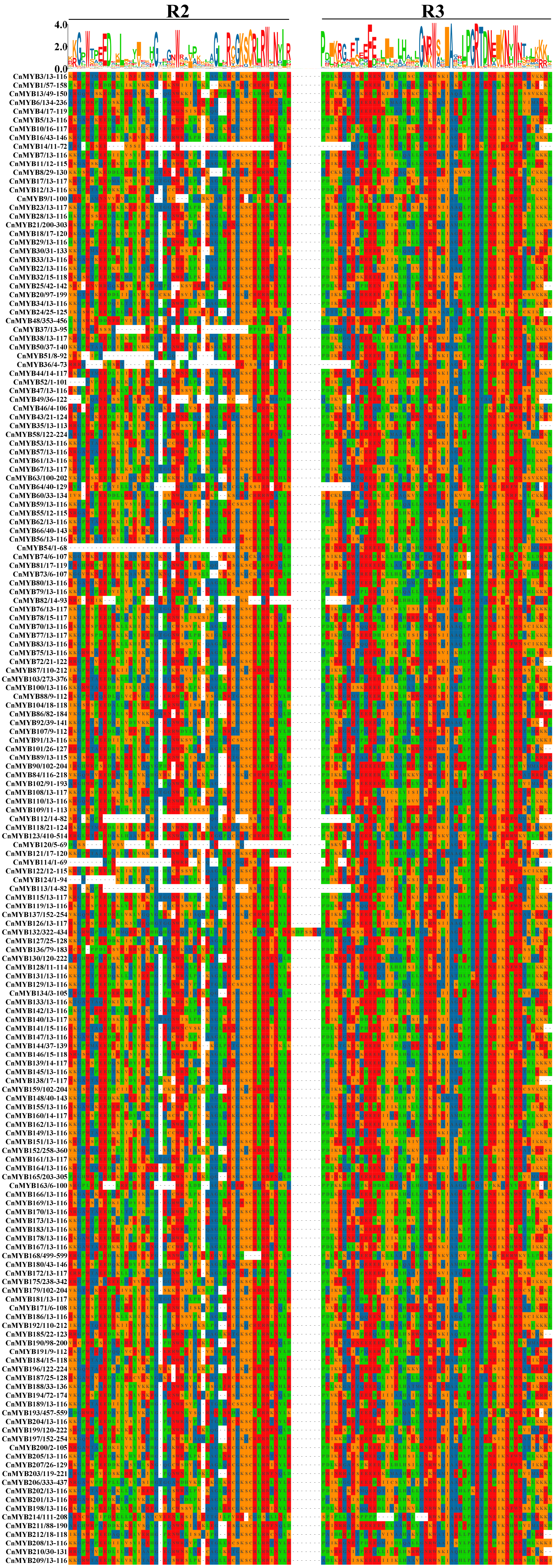
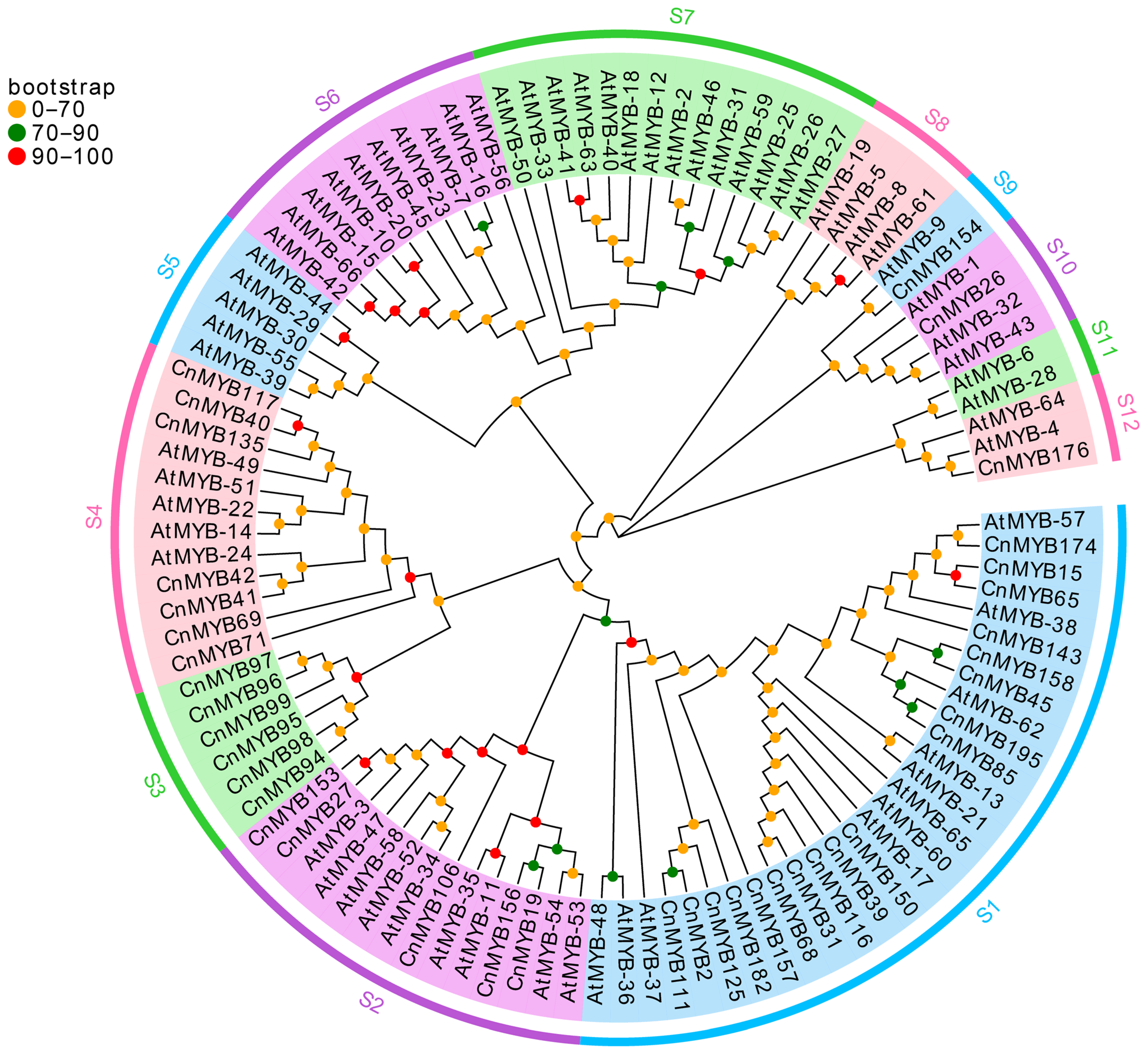
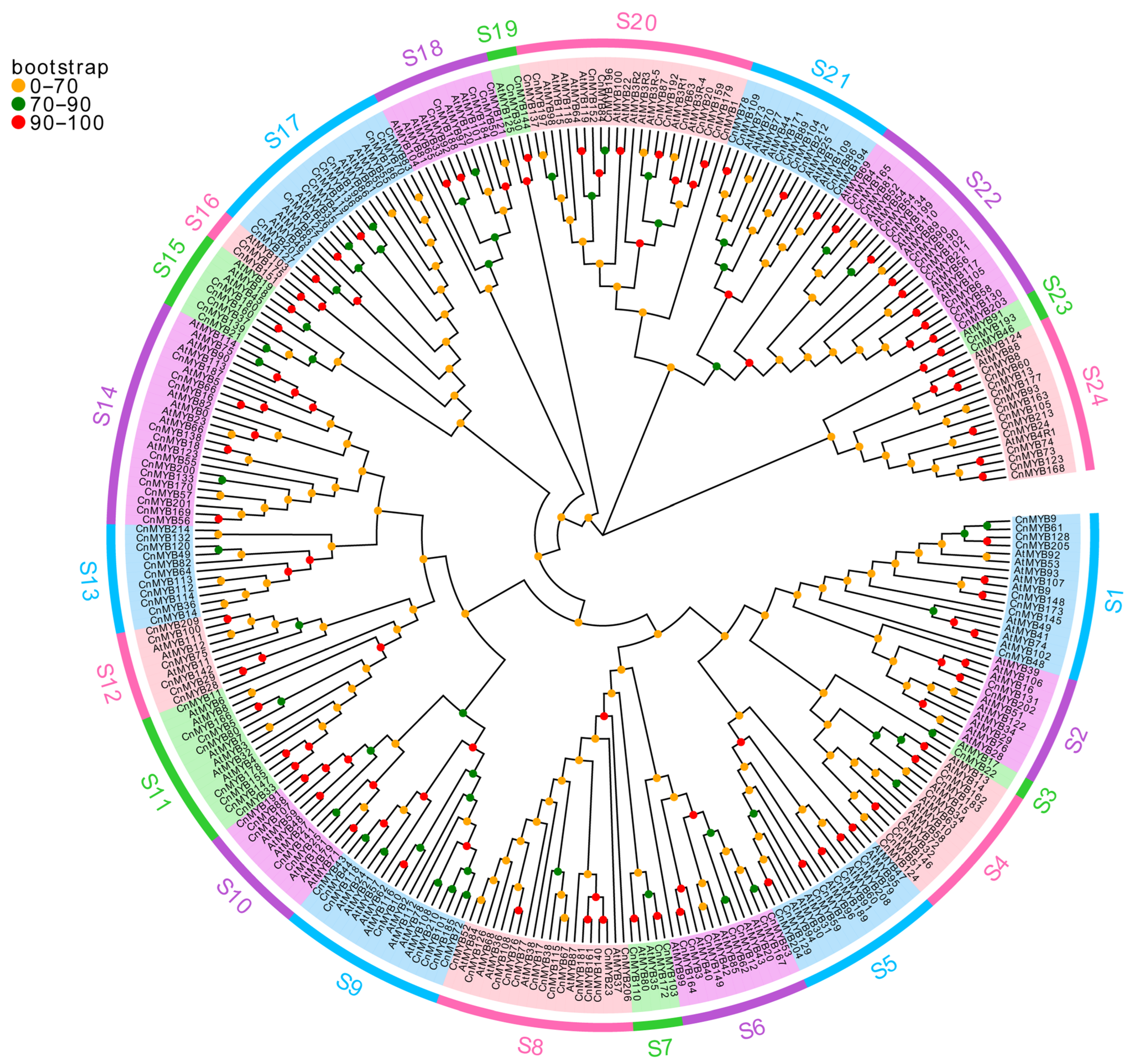
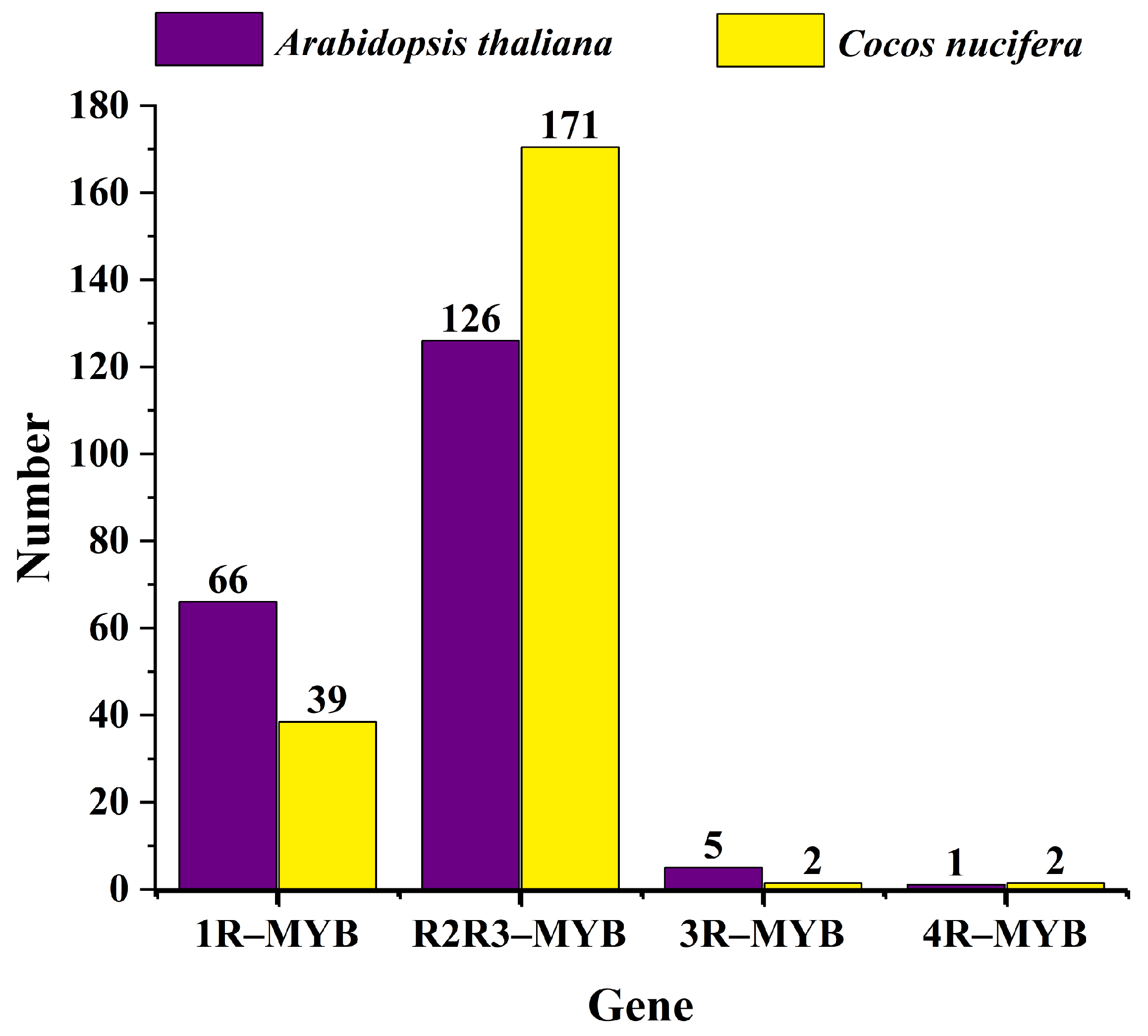
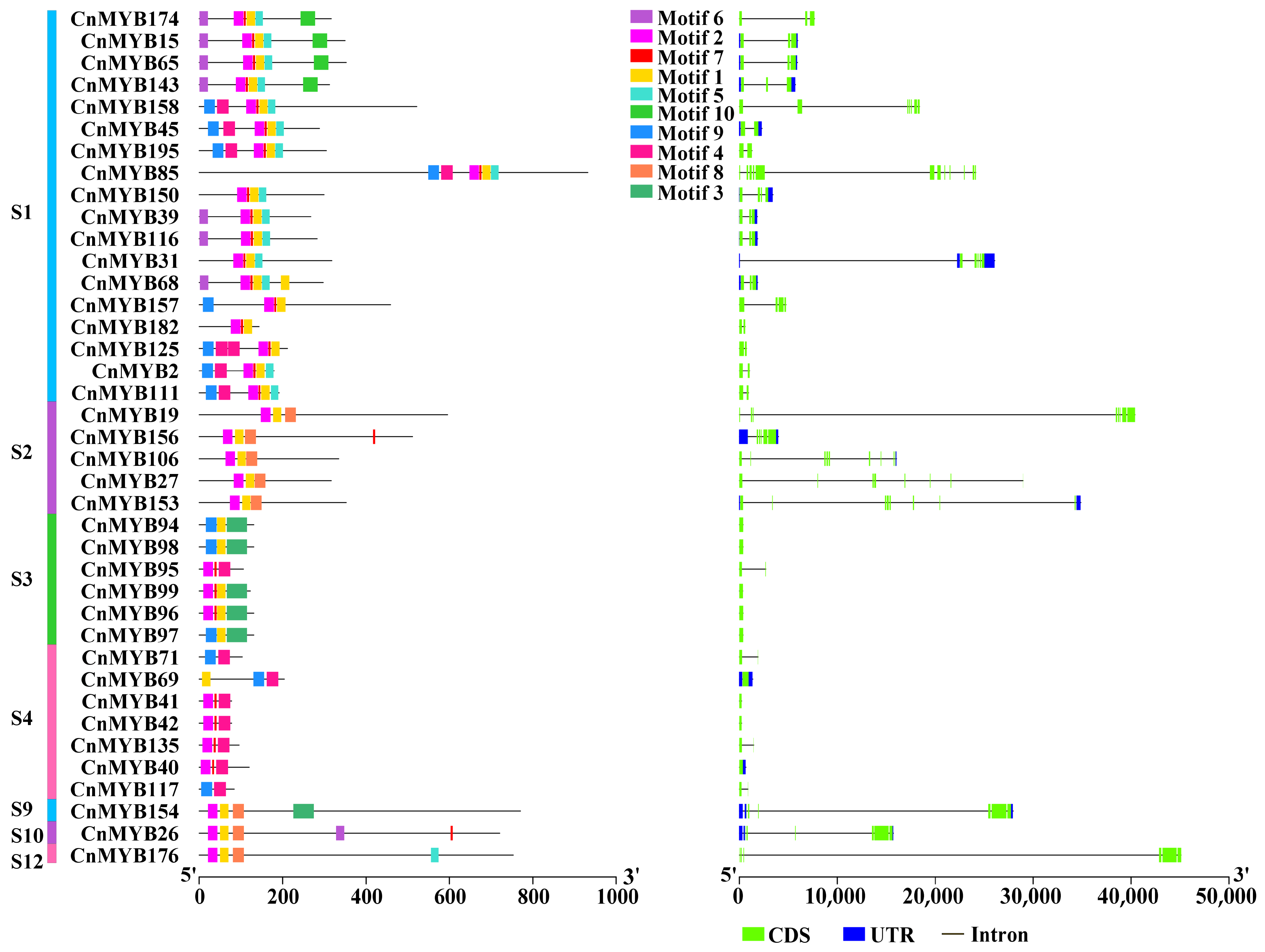
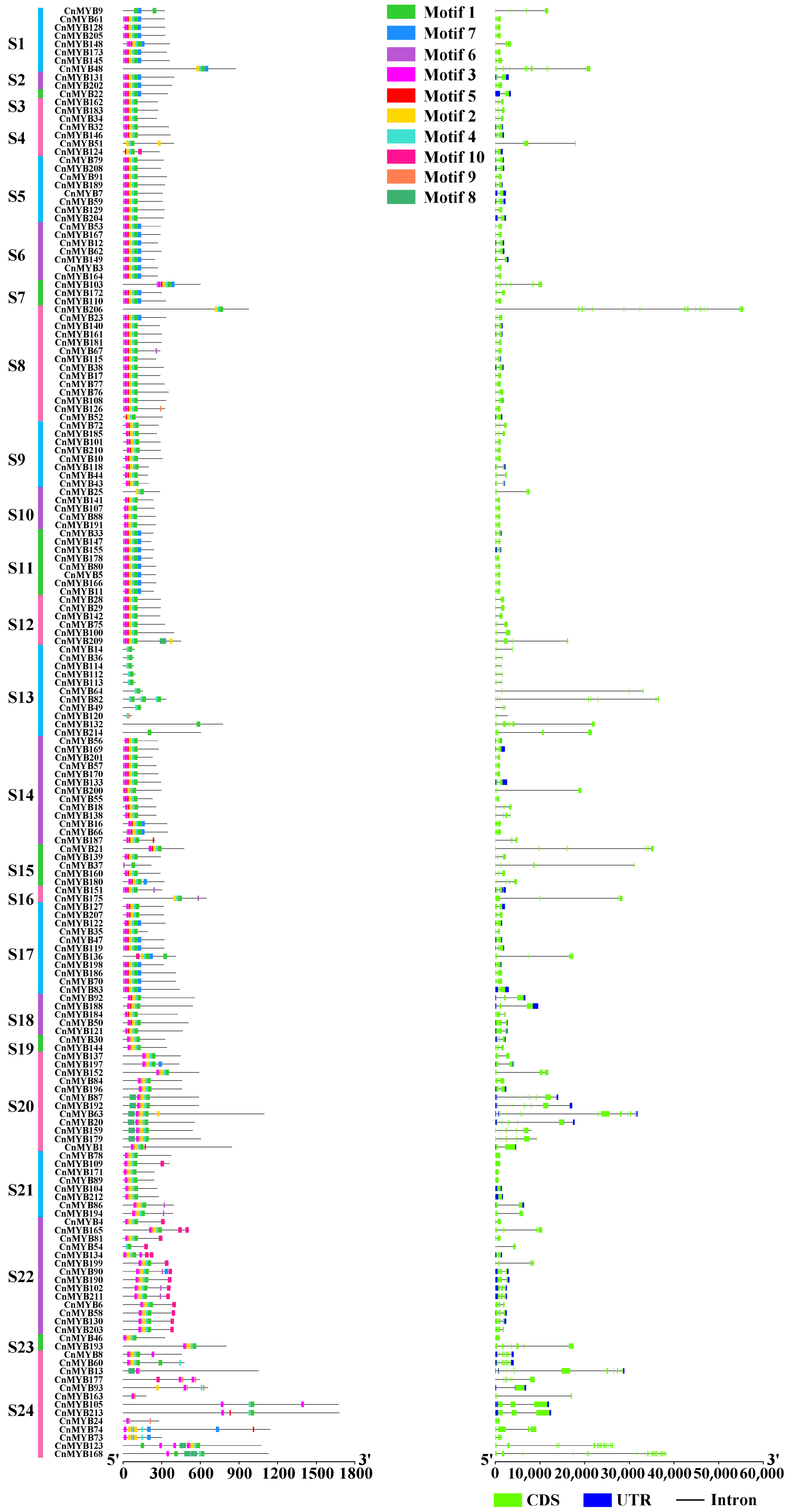
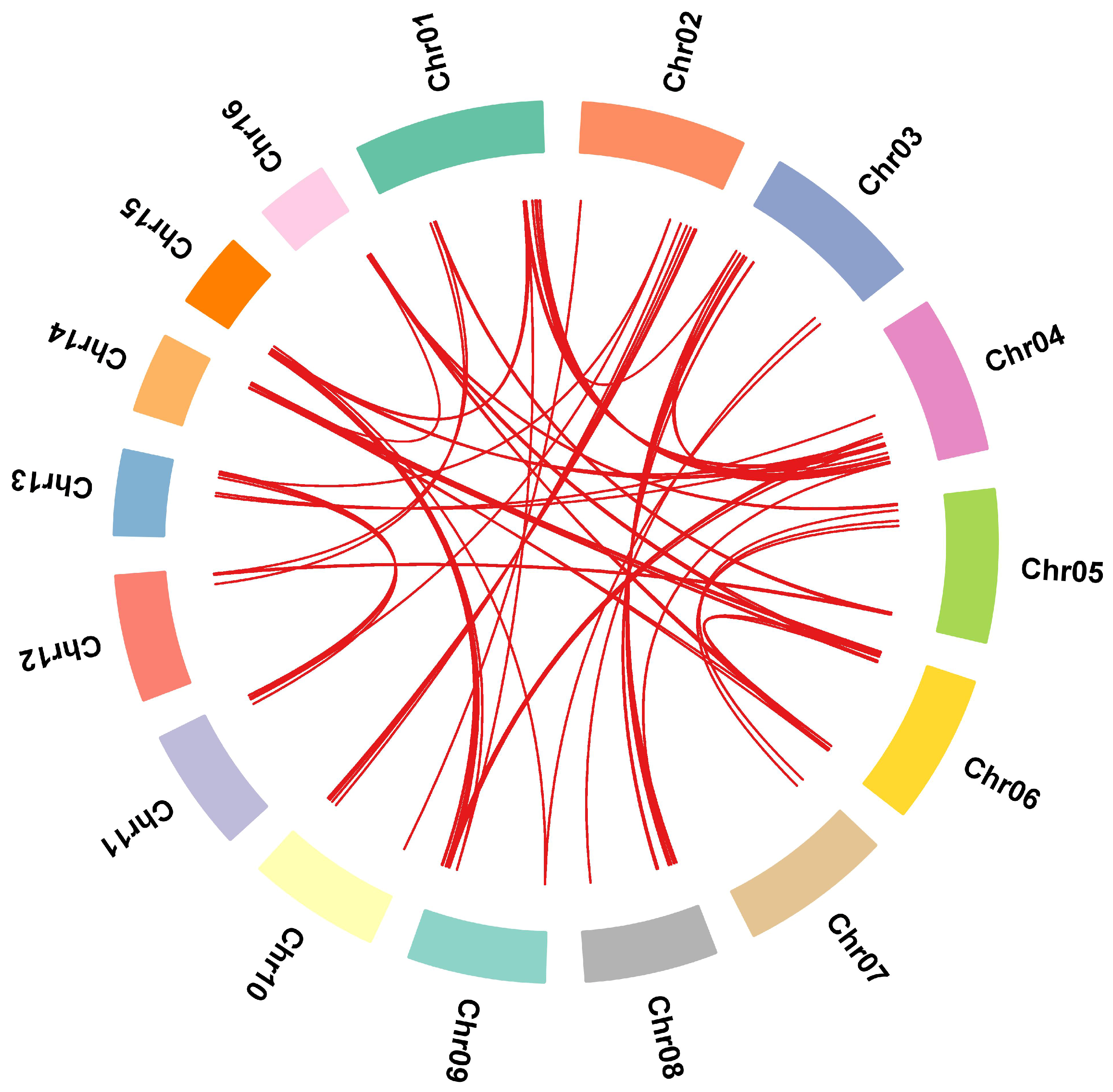
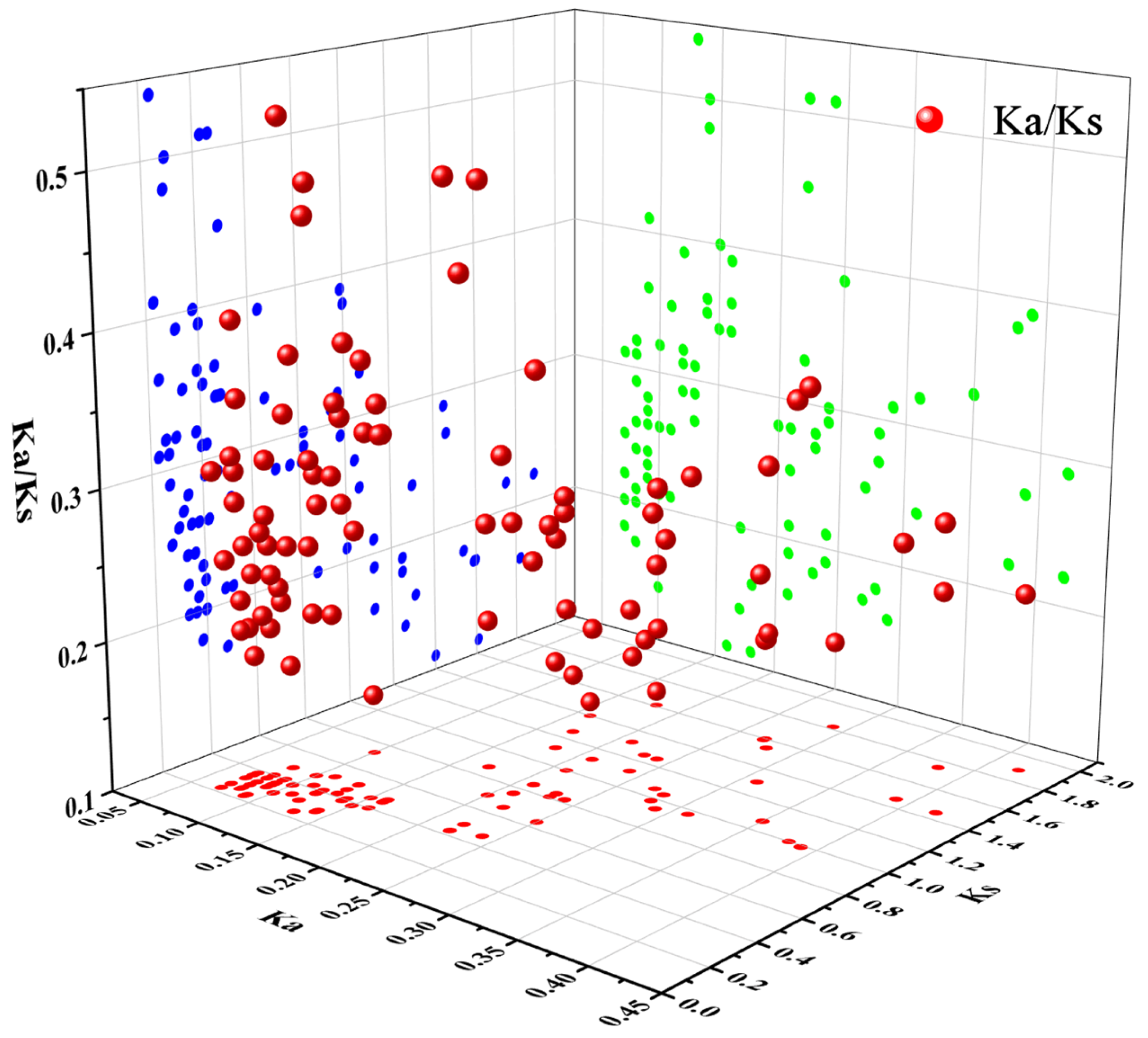
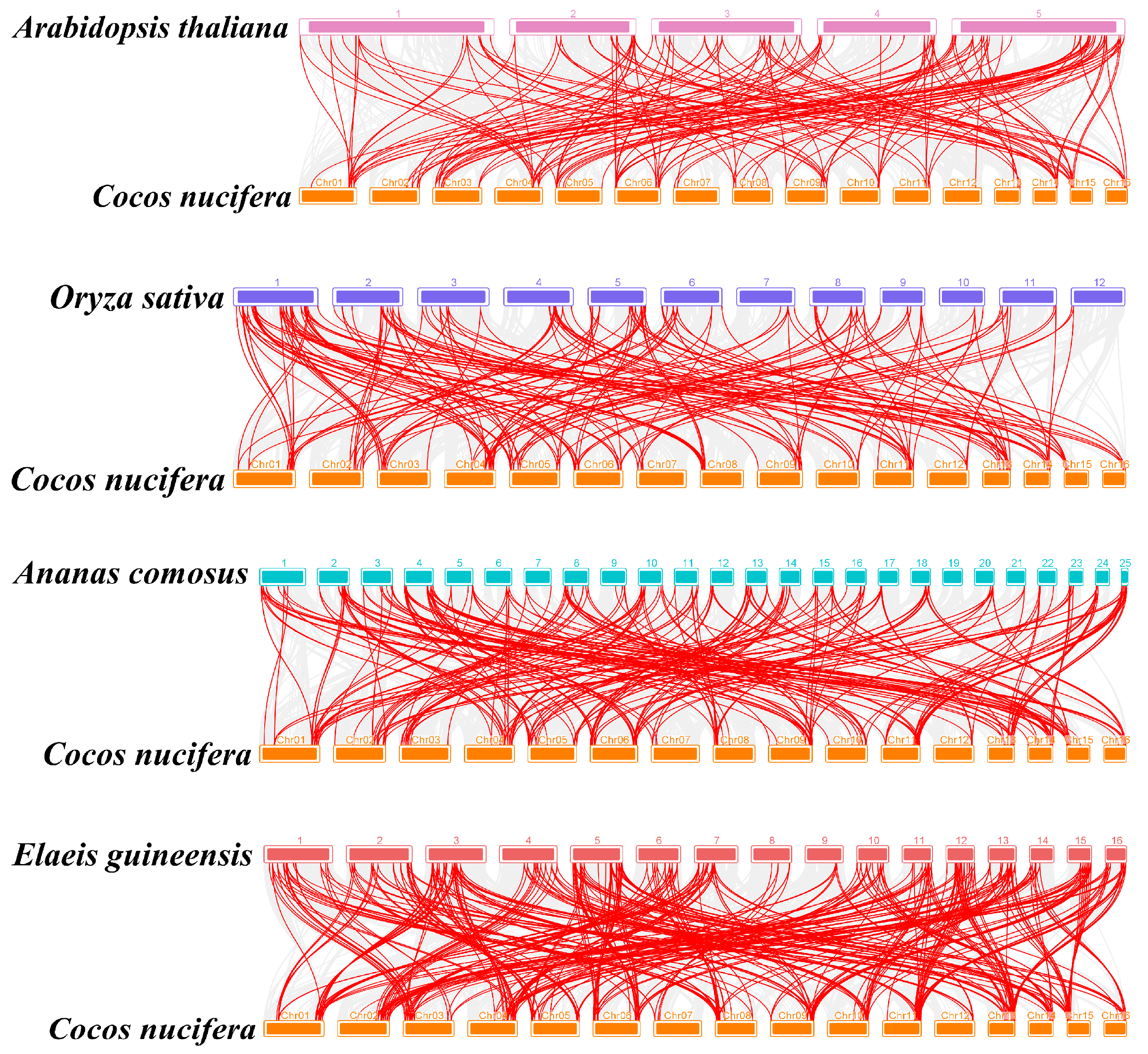
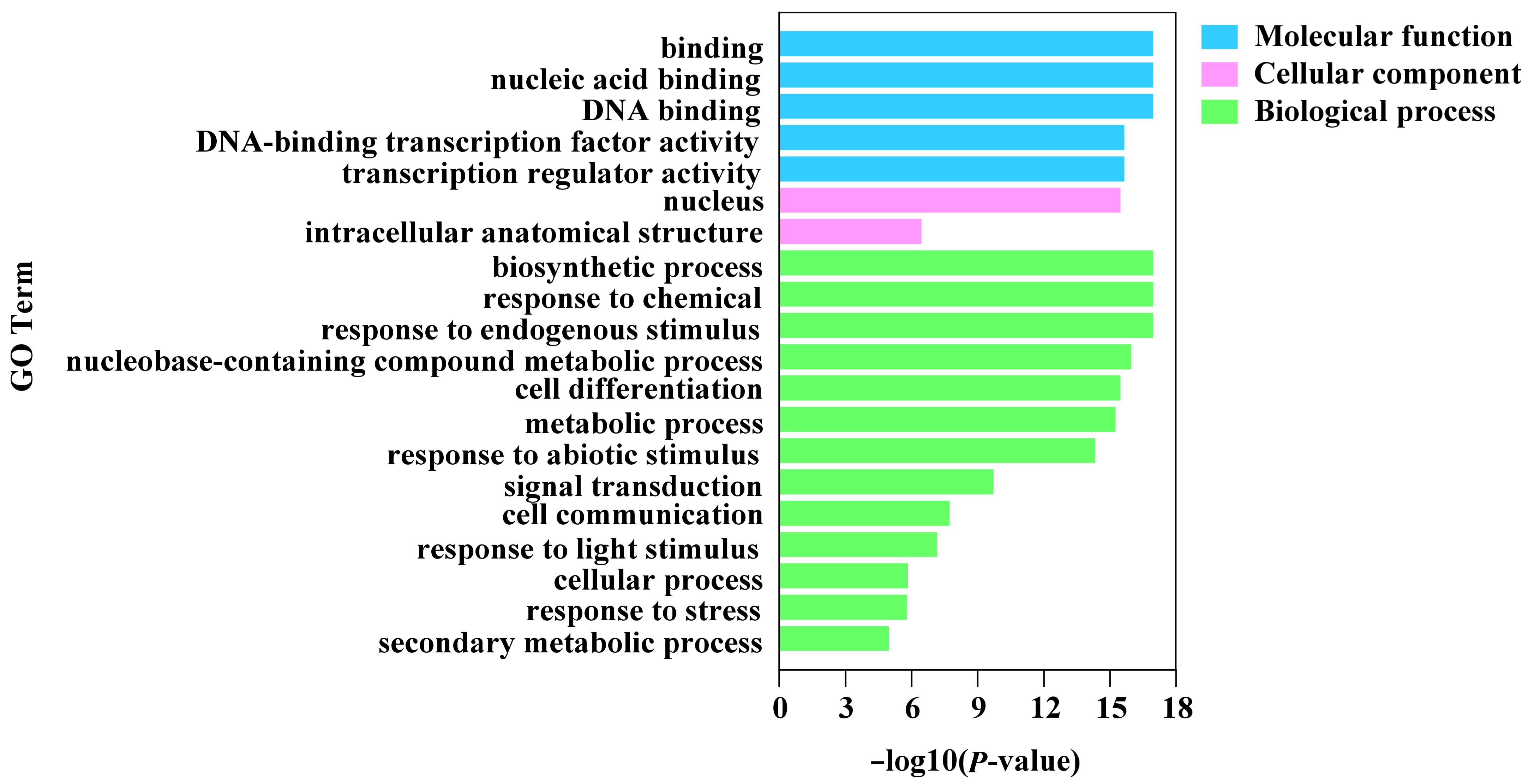
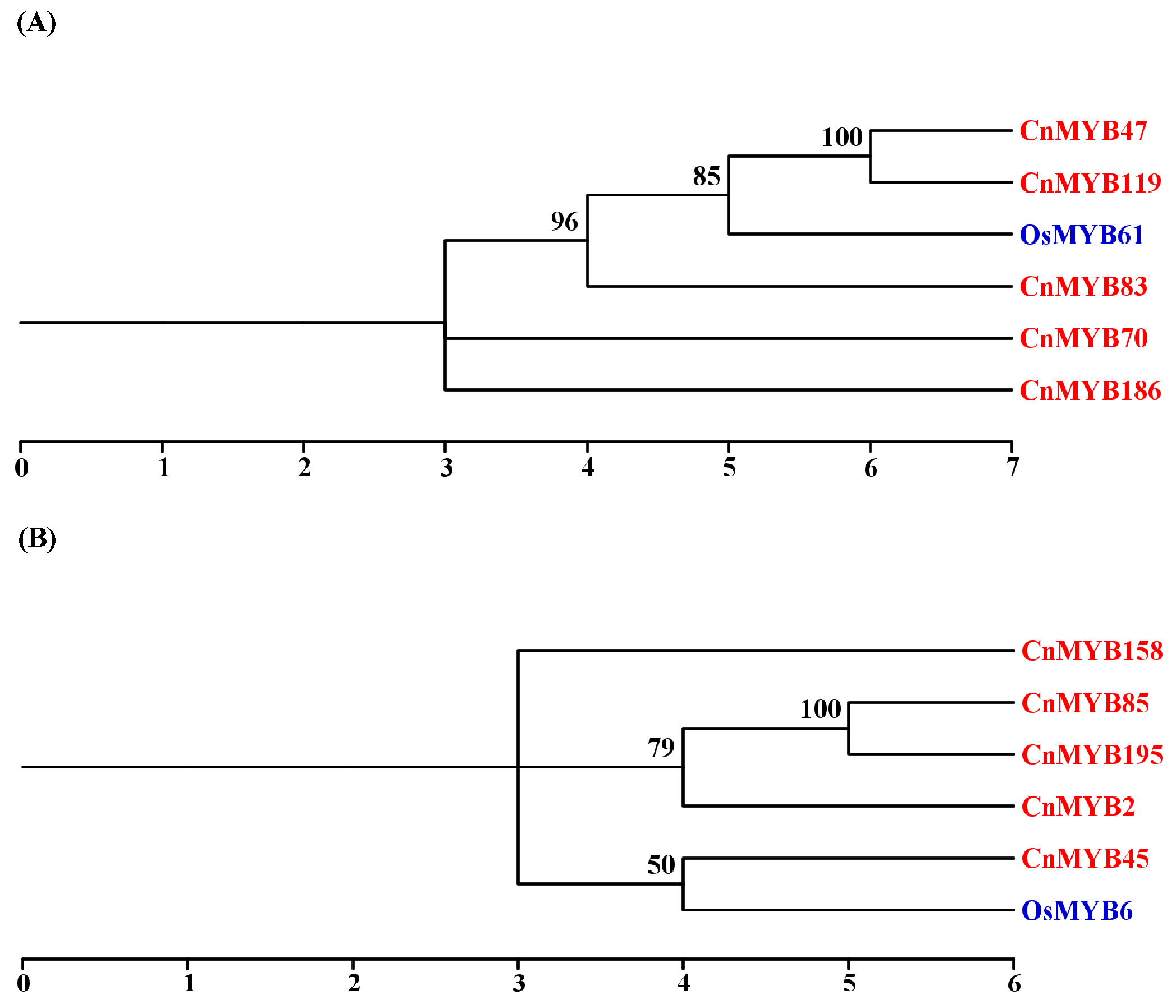
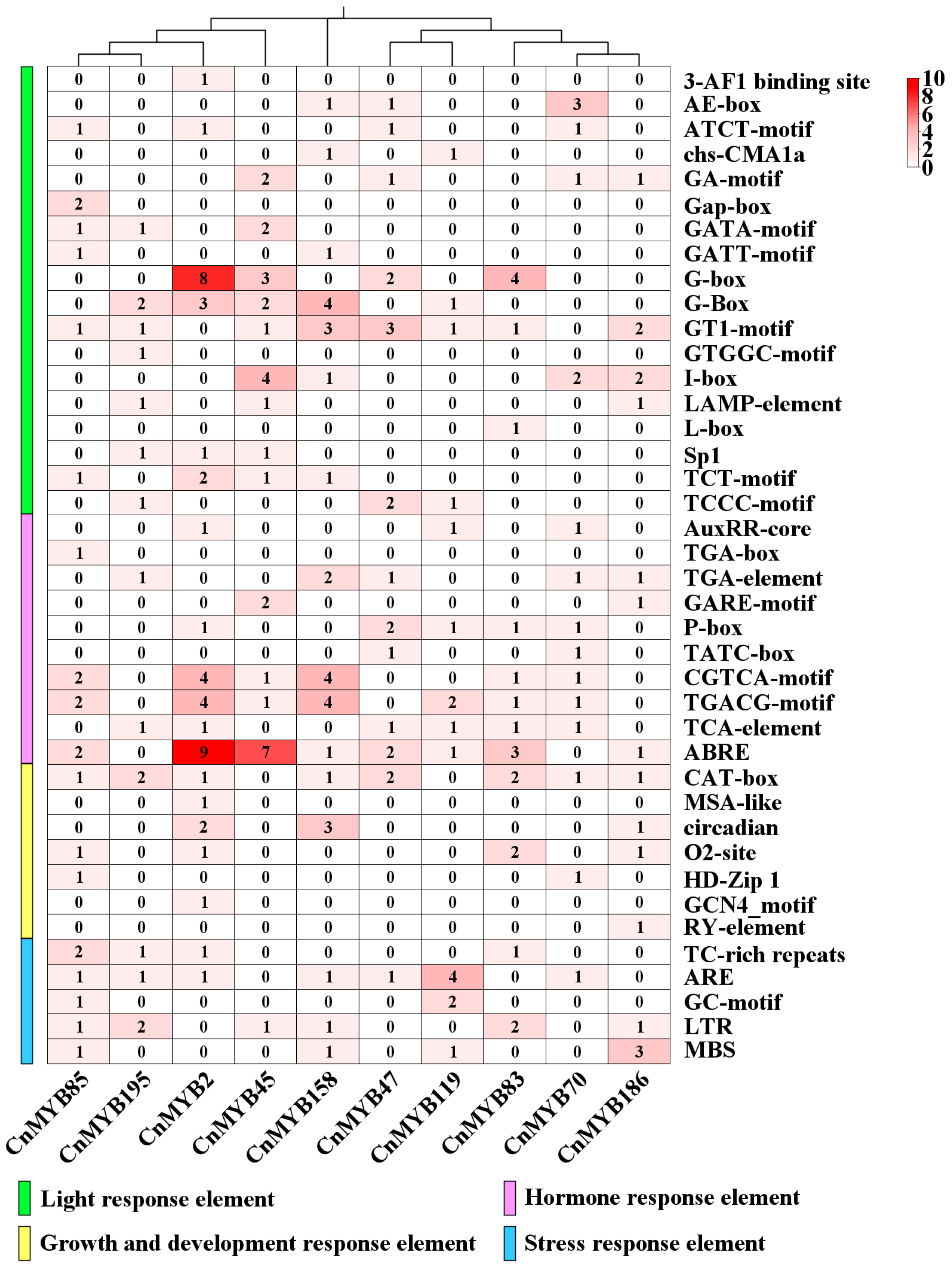
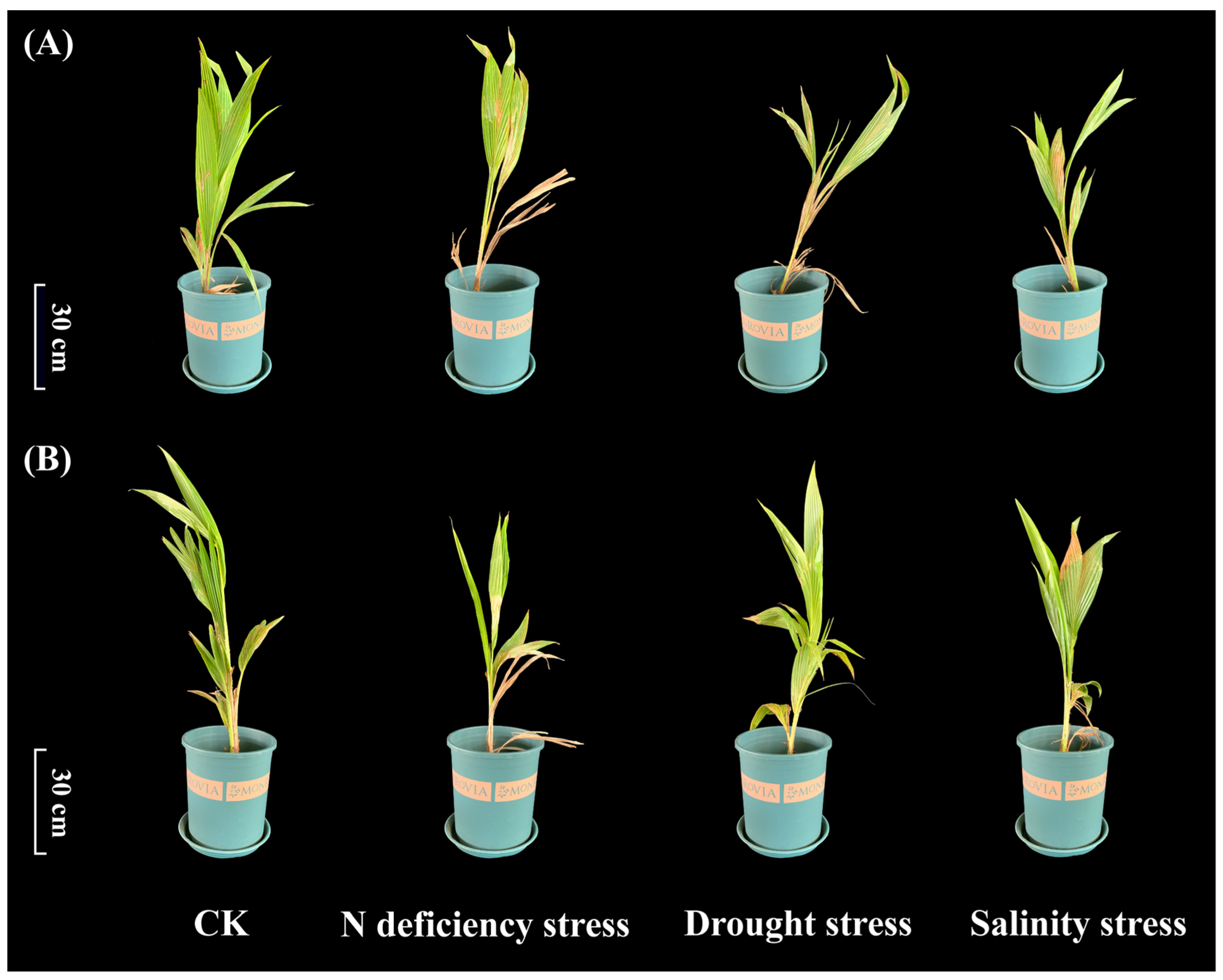
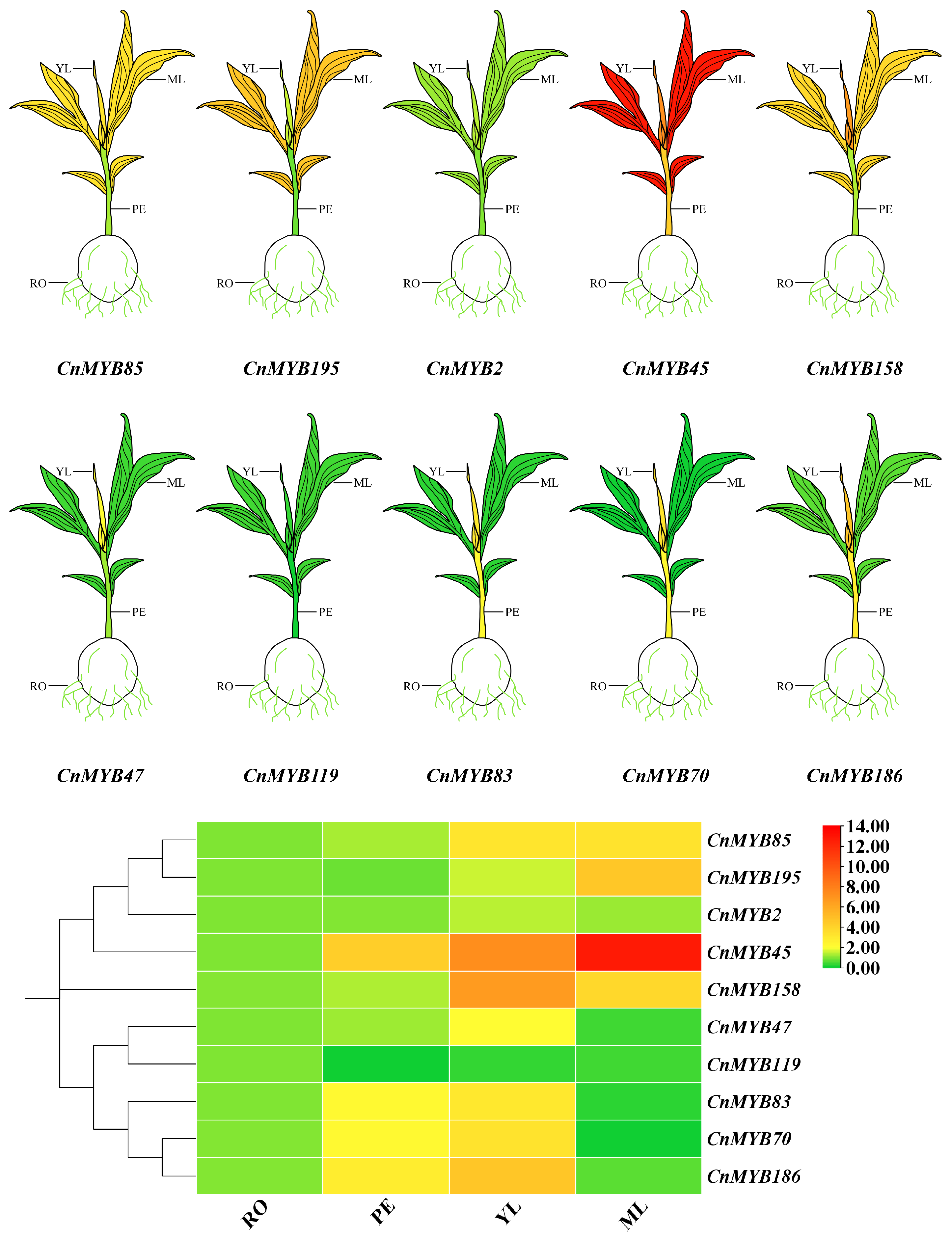
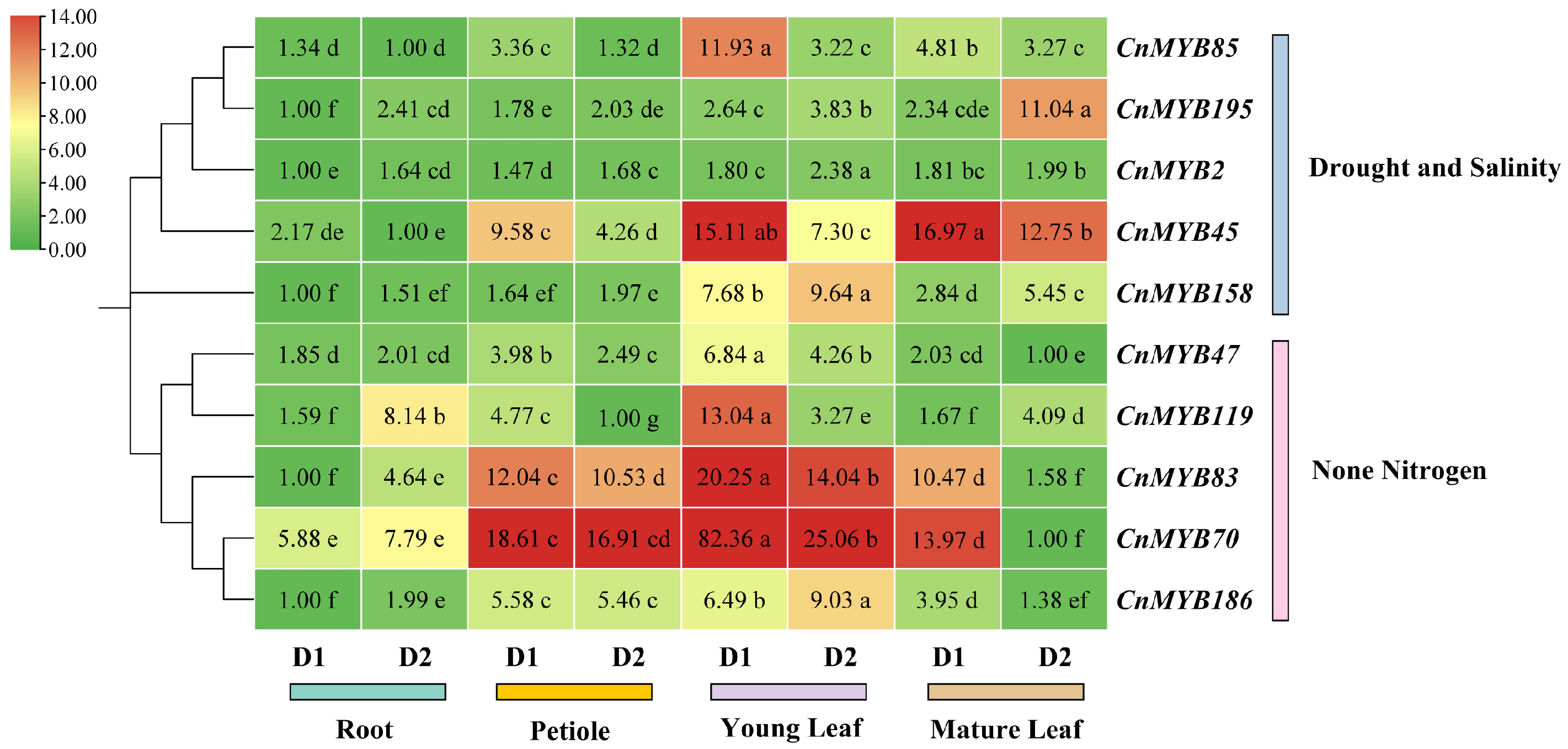
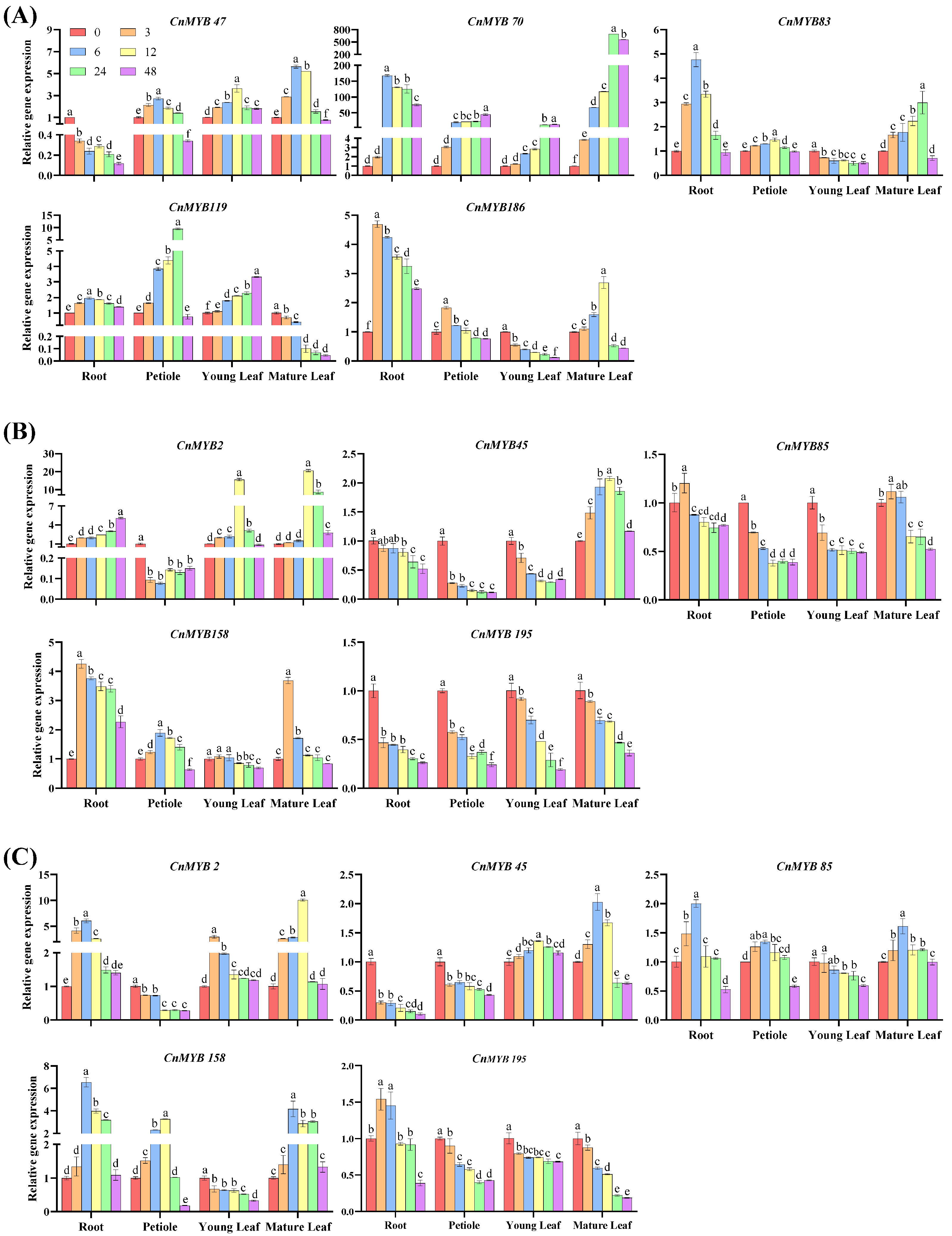
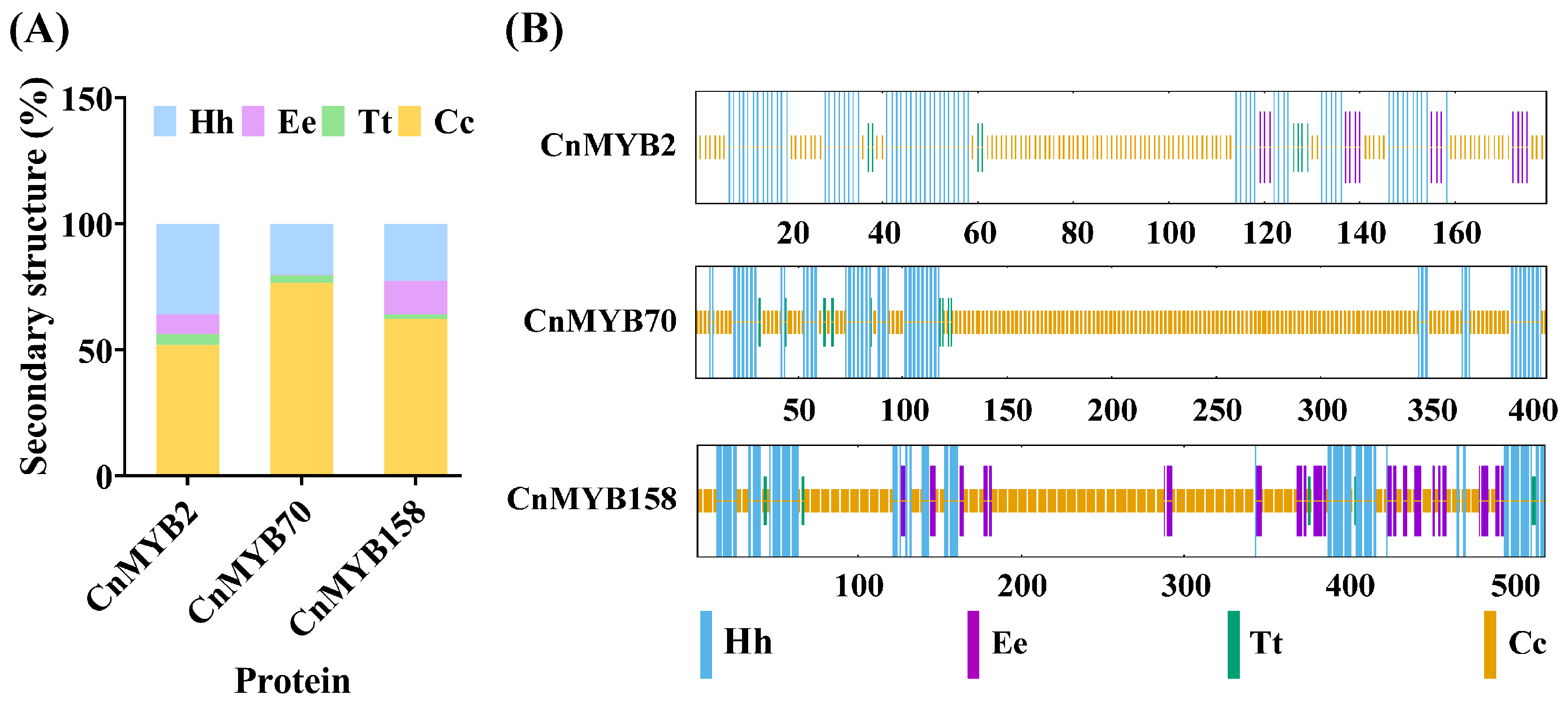


| Gene Name | Forward Primer Sequence (5′–3′) | Reverse Primer Sequence (5′–3′) |
|---|---|---|
| β–actin | ATAAAGTATGGCTGATGCTGAGG | CAACAATGCTTGGGAACACA |
| CnMYB2 | AAGGGCTGGCTAAGTATGG | GTATTCTGGTTCTGACGGATG |
| CnMYB45 | AAGACGGCGGCTCAGGTAAG | ATGGTGGTGGTCCTTCTCCTTG |
| CnMYB47 | TTCTGATAATAAGGTAGGCTC | GCAGGCTTCCGTTAGGTC |
| CnMYB70 | CAGTCCTTGGCAACAGATGGTC | GGGTCTCGGAAAGTGGTTTGTG |
| CnMYB83 | TGCTGCTCTCGATCCTTCTTCC | CCTGGCTGGCGACGAACC |
| CnMYB85 | TTACAGGGACTTGGAGGACGAC | GACGCAGTAGGATGGCTTGAAC |
| CnMYB119 | TGCCAGGGAGAACAGACAAT | GGCTTCACTGGCTGATGCTCT |
| CnMYB158 | ATCCCTGACGCTCACTTCTCC | TGGTTCGGCTTGTTCGCATTC |
| CnMYB186 | GTCTTGGGCAACAGATGGTCTC | TTGGGTCTCAGAAAGCGGTTTG |
| CnMYB195 | CCAGGACACCTACCCAAGT | AGAACTGGTCAGAGATTGTGGT |
Disclaimer/Publisher’s Note: The statements, opinions and data contained in all publications are solely those of the individual author(s) and contributor(s) and not of MDPI and/or the editor(s). MDPI and/or the editor(s) disclaim responsibility for any injury to people or property resulting from any ideas, methods, instructions or products referred to in the content. |
© 2024 by the authors. Licensee MDPI, Basel, Switzerland. This article is an open access article distributed under the terms and conditions of the Creative Commons Attribution (CC BY) license (https://creativecommons.org/licenses/by/4.0/).
Share and Cite
Si, C.-C.; Li, Y.-B.; Hai, X.; Bao, C.-C.; Zhao, J.-Y.; Ahmad, R.; Li, J.; Wang, S.-C.; Li, Y.; Yang, Y.-D. Genome-Wide Identification and Expression Analysis of MYB Transcription Factor Family in Response to Various Abiotic Stresses in Coconut (Cocos nucifera L.). Int. J. Mol. Sci. 2024, 25, 10048. https://doi.org/10.3390/ijms251810048
Si C-C, Li Y-B, Hai X, Bao C-C, Zhao J-Y, Ahmad R, Li J, Wang S-C, Li Y, Yang Y-D. Genome-Wide Identification and Expression Analysis of MYB Transcription Factor Family in Response to Various Abiotic Stresses in Coconut (Cocos nucifera L.). International Journal of Molecular Sciences. 2024; 25(18):10048. https://doi.org/10.3390/ijms251810048
Chicago/Turabian StyleSi, Cheng-Cheng, Yu-Bin Li, Xue Hai, Ci-Ci Bao, Jin-Yang Zhao, Rafiq Ahmad, Jing Li, Shou-Chuang Wang, Yan Li, and Yao-Dong Yang. 2024. "Genome-Wide Identification and Expression Analysis of MYB Transcription Factor Family in Response to Various Abiotic Stresses in Coconut (Cocos nucifera L.)" International Journal of Molecular Sciences 25, no. 18: 10048. https://doi.org/10.3390/ijms251810048
APA StyleSi, C.-C., Li, Y.-B., Hai, X., Bao, C.-C., Zhao, J.-Y., Ahmad, R., Li, J., Wang, S.-C., Li, Y., & Yang, Y.-D. (2024). Genome-Wide Identification and Expression Analysis of MYB Transcription Factor Family in Response to Various Abiotic Stresses in Coconut (Cocos nucifera L.). International Journal of Molecular Sciences, 25(18), 10048. https://doi.org/10.3390/ijms251810048






